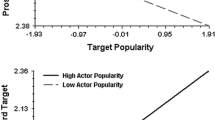Abstract
Classroom peer perceptions of 18 teacher-nominated hyperactive and 18 teacher-nominated active but normal elementary school-age boys, as revealed in two sociometric measures (Bower's Class Play, like-dislike nomination), were compared. Results indicated that hyperactives were significantly different from actives on all sociometric measures in that they were perceived more negatively. Peer communication patterns also were assessed. The communicative content, communicative quality, and attention to task instructions of hyperactive boys were compared to those of comparison boys. Limited support was found for the earlier finding that hyperactive boys were less likely than comparison boys to modulate behavior in response to changing external cues and to respond to subtle social learning opportunities. The communication task was found to be highly engaging for both groups of boys, and results suggest that hyperactive children may not lack the interpersonal skills necessary for referential communication, although they may be unable to use them consistently in all settings. The need to continue the study of peer relations of hyperactive children in naturalistic settings is stressed.
Similar content being viewed by others
Reference note
Dodge, K. A., Coie, J. D., & Brakke, N. P. Behavior patterns of socially rejected and neglected preadolescents: The roles of social approach and aggression. Manuscript submitted for publication, 1981.
References
Barker, R. G., & Wright, H. F.Midwest and its children. Hamden, Connecticut: Archon Books, 1971 (Originally published, 1955).
Bower, E.Early identification of emotionally handicapped children in school. Springfield, Illinois: Charles C Thomas, 1969.
Buchan, B., Swap, S., & Swap, W, Teacher identification of hyperactive children in preschool settings.Exceptional Children, 1977,43, 314–315.
Campbell, S. B., & Paulauskas, S. Peer relations in hyperactive children.Journal of Child Psychology and Psychiatry and A/lled Disciplines, 1979,20, 233–246.
Conners, C. K. A teacher rating scale for use in drug studies with children.American Journal of Psychiatry, 1969,126, 884–888.
Cowen, E. L., Pederson, A., Babijian, H., Izzo, L., & Trost, M. A. Long-term follow-up of early detected vulnerable children.Journal of Consulting and Clinical Psychology, 1973,41, 438–446.
Dodge, K. Social cognition and children's aggressive behavior.Child Development, 1980,54, 162–190.
Gottman, J., Gonso, J., & Rasmussen, B. Social interaction, social competence, and friendship in children.Child Develoment, 1975,46, 709–718.
Gottman, J. M. Toward a definition of social isolation in children.Child Development, 1977,48, 513–517.
Henker, B., & Whalen, K. The changing faces of hyperactivity: Retrospect and prospect. In C. K. Whalen & B. Henker (Eds.),Hyperactive children: The social ecology of identification and treatment. New York: Academic Press, 1980.
Klein, A. R., & Young, R. D. Hyperactive boys in their classroom: Assessment of teacher and peer perceptions, interactions, and classroom behaviors.Journal of Abnormal Child Psychology, 1979,7, 425–442.
Milich, R., & Landau, S. Socialization and peer relations in hyperactive children. In K. Gadow & I. Bialer (Eds.),Advances in learning and behavior disabilities. Greenwich, Connecticut: JAI Press, 1981.
Paulauskas, S. L., & Campbell, S. B. Social perspective-taking and teacher ratings of peer interaction in hyperactive boys.Journal of Abnormal Child Psychology, 1979,7, 483–493.
Peery, J. C. Popular, amiable, isolated, rejected: A reconceptualization of peer sociometric status in preschool children.Child Development, 1979,50, 1231–1234.
Rolf, J. E. Peer status and the directionality of symptomatic behavior: Prime social competence predictors of outcome for vulnerable children.American Journal of Orthopsychiatry, 1976,46, 74–88.
Routh, D. The clinical significance of open-field activity in children.Pediatric Psychology, 1975,3, 3–8.
Schleifer, M., Weiss, G. Cohen, N., Elman, M., Cvejic, H., & Krueger, E. Hyperactivity in preschoolers and the effect of methylphenidate.American Journal of Orthopsychiatry, 1975,45, 38–50.
Whalen, C. K., & Henker, B. The social ecology of psychostimulant treatment: A model for conceptual and empirical analysis. In C. K. Whalen & B. Henker (Eds.),Hyperactive children: The social ecology of identification and treatment. New York: Academic Press, 1980.
Whalen, C., Henker, B., Collins, B., McAuliffe, S., & Vaux, A. Peer interaction in a structured communication task: Comparisons of normal and hyperactive boys and of methylphenidate (Ritalin) and placebo effects.Child Development, 1979,48, 388–401.
Worland, J., North-Jones, M., & Stern, J. Performance and activity of hyperactive and normal boys as a function of distraction and reward.Journal of Abnormal Child Psychology, 1973,1, 363–377.
Young, R. D., & Klein, A. Hyperactive and active-normal boys: A naturalistic behavioral assessment. In K. Gadow & J. Loney (Eds.),Psychosocial aspects of drug treatment for for hyperactivity. Boulder, Colorado: Westview Press, 1981.
Author information
Authors and Affiliations
Additional information
This project was supported in part by BRSG Grant S07-RR0703, awarded by the Biomedical Research Support Grant Program, Division of Research Resources, National Institutes of Health. The authors wish to thank Chris Tetzloff, who served as an experimenter, and Mary Carter, Barbara Kunz, and Scott Bishop, who coded all project videotapes. The authors also wish to thank Carol K. Whalen for providing drawings, designs, and detailed descriptions of the “Space Flight” task, and Robert Sprague for providing the Conners Rating Scales on 90 clinically diagnosed hyperactive children.
Rights and permissions
About this article
Cite this article
King, C.A., Young, R.D. Peer popularity and peer communication patterns: Hyperactive versus active but normal boys. J Abnorm Child Psychol 9, 465–482 (1981). https://doi.org/10.1007/BF00917796
Revised:
Issue Date:
DOI: https://doi.org/10.1007/BF00917796




